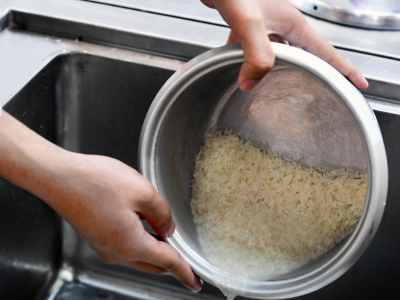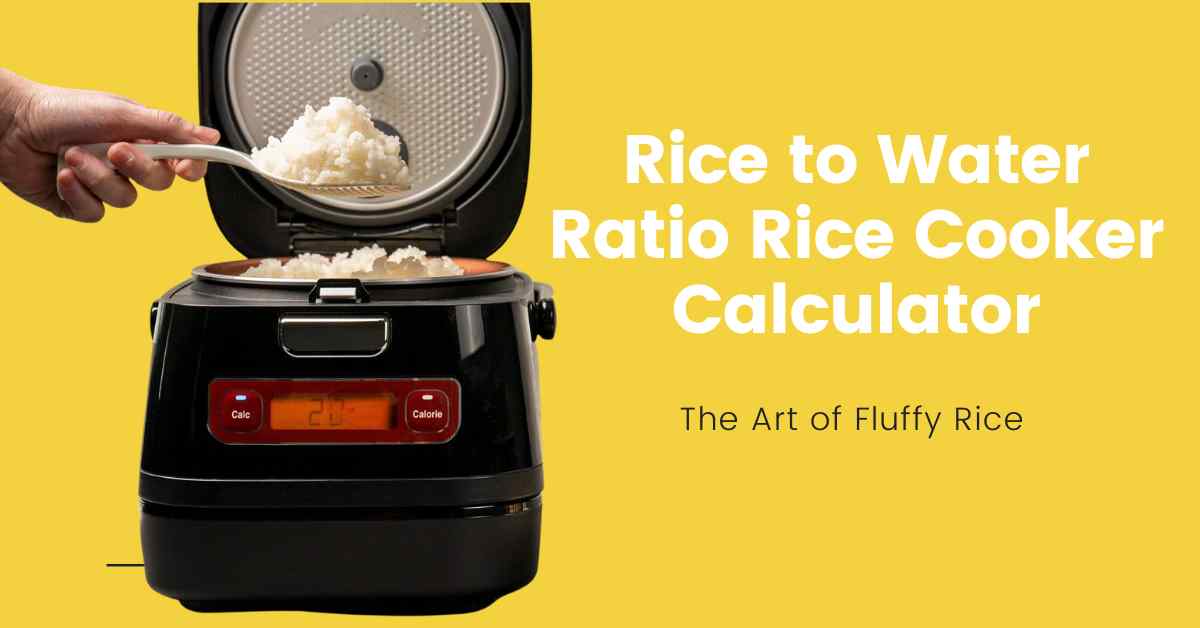The Rice to Water Ratio Rice Cooker Calculator helps you determine the exact amount of water to add to cooking rice in a rice cooker. Cooking rice in a rice cooker can be a convenient and foolproof way to achieve perfectly cooked and fluffy rice every time.
However, getting the rice to water ratio right is essential for achieving the desired consistency and texture. The Rice to Water Ratio Rice Cooker Calculator takes the guesswork out of this process by providing you with the accurate amount of water needed based on the type and amount of rice you are cooking.
Simply input the type of rice and the desired texture, and the calculator will give you the precise measurement of water required. With this handy tool, you can say goodbye to undercooked or mushy rice and enjoy perfectly cooked rice with ease.
Table of Contents
Why The Rice To Water Ratio Matters
The rice to water ratio is an important factor to consider when cooking rice in a rice cooker. Using the correct ratio ensures that your rice turns out perfectly cooked every time. It impacts the texture and consistency of the cooked rice, resulting in either mushy or undercooked grains if not measured correctly.
Using too much water can make the rice overly soft and sticky while using too little water can leave it dry and uncooked. The correct ratio strikes a balance between moisture and fluffiness.
By following the recommended rice to water ratio for your specific rice variety, you can achieve optimal results. Different types of rice may require slightly different ratios, so it’s important to consult the manufacturer’s instructions or reputable sources for accurate measurements.
Remember, getting the rice-to-water ratio right is vital to achieving perfectly cooked rice that is fluffy, separate, and full of flavor.
Calculating The Rice To Water Ratio
| Calculating the rice to water ratio is essential for perfect rice every time. Understanding the different types of rice is the first step in determining the correct ratio. Each rice variety has its own cooking requirements, which can affect the ratio. Some rice varieties, like jasmine or basmati, may require more water, while others, like short-grain or sticky rice, may need less. Factors such as the cooker type and desired rice texture also play a role. Different cooker types, such as conventional rice cookers or instant pots, may require slightly different ratios. Additionally, the desired texture, whether it’s fluffy or sticky, will affect the amount of water needed. When calculating the rice to water ratio, it is important to keep in mind the specific recommendations provided by the rice manufacturer. These guidelines can give you a starting point, and then you can adjust based on your preferences and experience. Experimenting with different ratios can help you achieve the perfect rice every time you use your rice cooker. |
Adjusting The Rice To Water Ratio

Adjusting the Rice to Water Ratio
Perfecting your rice is all about finding the right balance between the right amount of water and rice. There are a few factors to consider when adjusting the ratio to get that perfect fluffy texture and taste. Altitude and humidity play a role in how rice cooks, so take them into account. Additionally, rice soaking time also affects the final result. Experiment with different soaking times to find what works best for you. Moreover, don’t forget about additional ingredients such as broth or spices, as they can add depth of flavor to your rice. Keep in mind that trial and error is the key here. Adjust the ratio gradually until you achieve the desired consistency and flavor. Happy cooking!
Factors to consider when adjusting the ratio:
| Factors | Considerations |
|---|---|
| Altitude and humidity | They can affect the cooking time and absorption of water by rice. Adjust accordingly. |
| Rice soaking time | Experiment with different soaking times to find the perfect balance. |
| Additional ingredients | Broth, spices, or other ingredients can enhance the flavor of your rice. |
Tips And Tricks For Fluffy Rice

Choosing the right rice cooker
When it comes to choosing the right rice cooker, consider the size of your household and your rice consumption. Look for a cooker that suits your needs in terms of capacity and features. Some cookers have multiple settings for different types of rice, which can enhance the cooking process.
Preparing the rice properly
To achieve fluffy rice, it’s important to rinse the rice thoroughly before cooking. Rinse the rice under cold water until the water runs clear to remove any excess starch. Then, measure the rice accurately using the appropriate cup provided with your rice cooker. Following the recommended rice to water ratio calculator is crucial for perfect results.
Monitoring the cooking process
| Rice Type | Water Ratio | Cooking Time |
|---|---|---|
| White Rice | 1:1.5 | Approx. 15 minutes |
| Brown Rice | 1:2 | Approx. 30 minutes |
| Basmati Rice | 1:1.75 | Approx. 18 minutes |
| Short Grain Rice | 1:1.25 | Approx. 20 minutes |
Once you start the rice cooker, avoid opening the lid frequently as it may disrupt the cooking process and result in unevenly cooked rice. Be patient and let the cooker do its job until the cooking time is complete. Once cooked, let the rice sit inside the cooker for a few minutes before fluffing it with a fork.
Common Mistakes To Avoid
If you want perfectly cooked rice every time, it’s essential to avoid common mistakes. One of these is overcooking or undercooking the rice. Overcooking can result in mushy and soggy rice, while undercooking can leave it hard and unappetizing. To prevent this, make sure to follow the recommended cooking time for different types of rice. Another mistake is using incorrect measurements. It’s crucial to get the rice to water ratio right to achieve fluffy and flavorful rice. Neglecting the rice cooker settings is yet another common error. Each rice cooker has specific settings for different types of rice, such as white, brown, or sushi rice. Make sure to select the appropriate setting according to the type of rice you’re cooking. By avoiding these mistakes, you can enjoy perfectly cooked rice every time you use your rice cooker.
Troubleshooting Rice Cooking Issues
Cooking sticky or gummy rice can be frustrating, but a few adjustments can help. Firstly, make sure you are using the correct rice to water ratio. For stickier rice, increase the water slightly. Additionally, rinsing the rice before cooking can remove excess starch, resulting in less stickiness. It’s also important to avoid lifting the lid during the cooking process to prevent steam from escaping.
If your rice still turns out sticky, try letting it sit in the rice cooker for a few minutes after it has finished cooking. This allows the residual heat to evaporate excess moisture, making the rice less sticky. Finally, using a fork or rice paddle to fluff the cooked rice gently can help separate the grains and reduce stickiness.
If you find that your rice is often burned or undercooked, it may be due to an issue with the cooking time or temperature. Check the manufacturer’s instructions for recommended settings and adjust accordingly. Using a high-quality rice cooker with precise temperature control can also help ensure proper cooking.
When cooking rice, be sure to measure both the rice and water accurately. Too much water can result in undercooked rice, while too little can lead to burning. It’s also important to avoid opening the lid during cooking to maintain consistent heat and moisture.
| Issue | Remedies |
|---|---|
| Sticky or gummy rice | Increase water ratio. Rinse rice before cooking. Let it sit in the rice cooker after cooking. Fluff gently. |
| Burned or undercooked rice | Check cooking time and temperature. Use recommended settings. Measure rice and water accurately. Avoid opening the lid during cooking. |
Enhancing Flavor And Texture Of Cooked Rice
Aromatic ingredients such as ginger, garlic, and bay leaves can go a long way in elevating the flavor profile of cooked rice. By adding these ingredients to the rice cooker, their fragrant oils infuse into the rice, resulting in a more delicious and aromatic dish.
Herbs and spices are another great way to enhance the taste of cooked rice. Cilantro, basil, turmeric, or cumin can be added to the rice cooker before cooking, adding depth and complexity to the dish. Experiment with different combinations to find your preferred flavor profile.
Apart from adding ingredients, you can also experiment with different cooking methods to achieve the desired texture of rice. For example, using the absorption method allows the rice to fully absorb the water, resulting in fluffy grains. Alternatively, the pilaf method involves sautéing the rice before adding liquid, resulting in a nuttier and more flavorful outcome.
Frequently Asked Questions For Rice To Water Ratio Rice Cooker Calculator
How Much Water Do I Use For 2 Cups Of Rice In A Rice Cooker?
For 2 cups of rice in a rice cooker, use double the amount of water. So, you should use 4 cups of water.
How Much Water Do I Need For 1 Cup Of Rice In A Rice Cooker?
For 1 cup of rice in a rice cooker, use 1. 5 cups of water.
What Is The Ratio Of 1 2 Cup Rice To Water?
The ratio of 1/2 cup of rice to water is 1:1. So, you’ll need equal amounts of rice and water – 1/2 cup of rice and 1/2 cup of water.
How Much Water Do You Need For 8 Cups Of Rice?
For 8 cups of rice, you typically need about 16 cups of water.
Conclusion
To ensure perfectly cooked rice every time, the rice to water ratio is crucial. By using a rice cooker calculator, you can accurately measure the amount of water needed to cook your rice to perfection. This handy tool takes the guesswork out of the equation and guarantees fluffy and delicious rice.
Say goodbye to overcooked or undercooked rice with this convenient and reliable method. Happy cooking!
